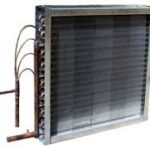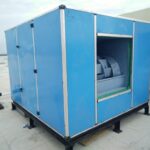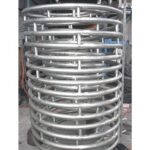Plenum Box
Plenum Box serves as a junction point in HVAC ductwork, collecting conditioned air from a main supply duct and evenly distributing it to multiple outlets or diffusers throughout a building. It typically features adjustable dampers to control airflow rates to each outlet, ensuring balanced air distribution. Plenum boxes are designed with insulation to prevent thermal losses or gains within the duct system, optimizing energy efficiency. They are essential components in achieving uniform air distribution, maintaining indoor comfort levels, and improving HVAC system performance across various applications.

Plenum Box
Role of
- Air Distribution Hub: The plenum box acts as a central hub where conditioned air from the AHU is collected and evenly distributed to various ducts, diffusers, or air outlets throughout a building or space.
- Flow Control: It facilitates controlled airflow by integrating dampers or other airflow control devices. These components regulate the volume and direction of air entering different ducts or zones, ensuring balanced distribution and maintaining desired environmental conditions.
- Pressure Equalization: Plenum boxes help equalize air pressure within the HVAC system. They accommodate changes in airflow rates and pressures generated by the AHU, preventing backflow or excessive pressure differentials that could impact system performance.
- Noise Reduction: By reducing turbulence and controlling airflow smoothly, plenum boxes contribute to noise reduction within the HVAC system. This is crucial in maintaining comfort and minimizing disturbances in occupied spaces.
- Air Quality Maintenance: Ensuring air quality is maintained is another role of the plenum box. By distributing conditioned air efficiently, it helps deliver fresh, filtered air to occupied spaces, supporting indoor air quality standards and occupant comfort.
Plenum Box
Materials and Components
| Material | Description | Common Applications |
|---|---|---|
| Galvanized Steel | Strong, durable, and corrosion-resistant due to zinc coating. Provides structural integrity and longevity. | Commercial buildings, industrial facilities, outdoor HVAC systems |
| Aluminum | Lightweight, corrosion-resistant, and easy to fabricate. Offers good thermal conductivity and resistance to rust. | Residential HVAC systems, aerospace, automotive |
| Stainless Steel | Highly durable and resistant to corrosion. Provides aesthetic appeal and ease of maintenance. | Hospitals, laboratories, marine environments |
| Fiberglass Reinforced Plastic | Non-corrosive, lightweight, and offers excellent chemical resistance. Suitable for harsh environments and where moisture control is critical. | Chemical processing plants, laboratories |
| PVC (Polyvinyl Chloride) | Affordable, lightweight, and resistant to chemicals. Used where chemical resistance and cost-effectiveness are priorities. | Laboratories, clean rooms, residential HVAC |
| CPVC (Chlorinated PVC) | Similar to PVC but with improved heat resistance. Offers good chemical resistance and affordability. | Industrial HVAC systems, water treatment facilities |
| Composite Materials | Combines properties of different materials for specific performance requirements. May include enhanced insulation or temperature resistance. | Specialized HVAC applications, extreme environment settings |
Plenum Box
Advantages of
- Plenum boxes ensure even distribution of conditioned air to various zones or rooms within a building, maintaining consistent comfort levels.
- They incorporate dampers or valves that allow precise regulation of airflow, optimizing HVAC system performance and energy efficiency
- Plenum boxes help balance air pressure throughout the ductwork, preventing issues like backflow and ensuring smooth operation of the system.
- By controlling airflow smoothly, plenum boxes minimize turbulence and associated noise levels, enhancing occupant comfort.
- Some plenum boxes include insulation to reduce heat loss or gain within ducts, improving energy efficiency and maintaining desired indoor temperatures.
- By delivering conditioned air efficiently, plenum boxes help maintain indoor air quality by distributing fresh, filtered air throughout the building.
Plenum Box
Specification Details
| Specification | Description |
|---|---|
| Material | Galvanized steel, aluminum, stainless steel, fiberglass reinforced plastic (FRP), or PVC/CPVC construction for durability, corrosion resistance, and application suitability. |
| Size Options | Various dimensions to accommodate different duct sizes and airflow volumes, customizable for specific project needs. |
| Insulation | Optional thermal insulation to minimize heat transfer and maintain temperature control within ductwork. |
| Construction | Robust welded or riveted construction with reinforced corners and flanged edges, ensuring structural integrity and leak-free operation. |
| Dampers | Adjustable dampers for precise airflow regulation, strategically positioned at inlet and outlet connections for optimal control. |
Other Air Handling Units We Manufacture
Direct Expansion Coils
Direct Expansion Coils also known as evaporator coils, are heat exchangers used in HVAC systems where refrigerant directly absorbs heat from the air passing over the coils

Air Washer Unit
Air Washer Unit is a type of HVAC equipment that combines air cleaning and humidification functions in one system. It uses a water-saturated filter or media

Heat Transfer Coils
Heat Transfer Coils are components used in HVAC systems to either add or remove heat from the air flowing through them. They consist of tubes that carry a heating or cooling medium

Mist Eliminators
Mist Eliminators, also known as demisters or mist extractors, are devices used to remove liquid droplets (mist) from gas streams. They work by using various mechanisms

Volume Control Dampers
Volume Control Dampers are mechanical devices used in HVAC systems to regulate and control the volume of airflow within ductwork. They adjust the size of the duct opening, typically through adjustable blades

